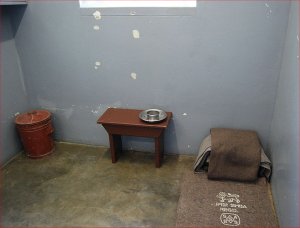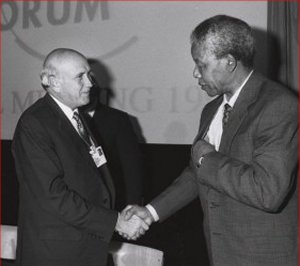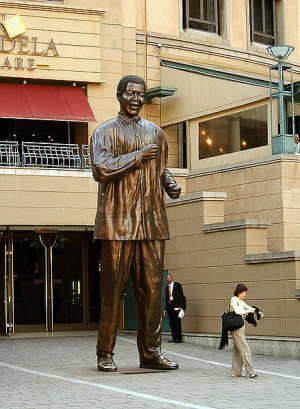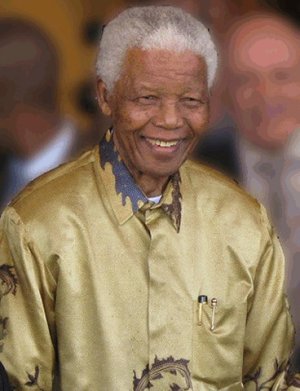In the 1800's the British came to colonize the country, so now three groups were in a conflict for the land. The British and the Dutch joined forces and instituted white rule. They made laws governing where blacks and coloureds (those of mixed race) could travel, and where they could work. Ninety percent of the land was owned by whites.
MANDELA'S EARLY LIFE
Nelson Mandela was born in South Africa July 18, 1918. He was given the name Rolihlahla which means "pulling the branch of a tree" or "troublemaker". He was later called by the name "Nelson" by one of his teachers on his first day of school.
His father, who was known as Hendry, was an important man of royal blood in his Thembu tribe. He had four wives and thirteen children. Nelson was his youngest son. Once when Hendry was in a fight with the local white government he lost his job and his possessions. He had to send his wife and son Rolihlahla to live with relatives. The family lived a happy life in three huts which his mother made out of mud bricks. There was one hut for cooking, one for sleeping, and one for storage. Everything they ate was something they grew or made themselves. When he was 5 years old he helped the other boys herd the cattle from pasture to pasture.
Mandela's mother converted to Methodism, a Protestant group. Rolihlahla was baptized and sent to a local Christian mission school. His father died when Nelson was nine and the boy was adopted by a friend, Chief Jongintaba Dalindyebo, who was the governor of the Thembu people. In this setting Nelson had good role models and learned about governing.
When he was 16 he was sent to a boarding school, the Methodist institution of Clarkebury and then to a larger school called Healdtown. At Healdtown he took up long-distance running and boxing. He enjoyed the discipline and the solitude running afforded him. It was at Healdtown he learned about the African National Congress (ANC) which had been formed in 1912. It was the first organization to be formed to free the South African blacks from colonial rule. They advocated full citizenship for Africans. Later in the 1940's Mandela and others would lead to end apartheid in South Africa.
After graduating from Healdtown he attended college at Fort Hare. During his second year he was expelled because he refused to serve on the Students' Representative Council to which he was elected.
His benefactor* was in poor health and wanted before his death to see his son Justice and Nelson take wives, so he arranged marriages for them. The two young men did not want the marriages even though the regent,* according to custom, could arrange them. They had little money and a single suitcase. They sold two of the regent's prize oxen and used the money for transportation. They rode the train to Queenstown.
EARLY CAREER
Later after a move to Johannesburg, Nelson worked as a clerk and messenger in a law office. His pay was meager and he often went hungry. He had one hot meal a week courtesy of his kind landlord Mr. Xhoma. He studied and by the end of 1942 he had received a BA degree.
Mandela married Evelyn Mase who was training as a nurse in Johannesburg. They had a son Madiba (muh DEE buh), whom they called Thembi. Mandela himself preferred to be called Madiba which was his clan name. It had also been the name of a Thembu chief who ruled in the 18th century. The state allocated the family a small house when their child was born.
APARTHEID*
The idea of apartheid had been around for centuries with blacks and coloureds being treated as inferior people. But when laws were passed restricting where they could live, trade, and buy property, it became obvious that what few rights they had were taken away.
Sophiatown, a community of 50,000 Africans was taken over by the Europeans. Africans had lived and held property in Sophiatown for 50 years. There was a campaign to remove the Africans from Sophiatown. For two years (1954-1955) they fought the removal. They had a slogan "Over Our Dead Bodies", but in the end they allowed themselves to be driven out rather than risk violence and disaster. They were forcibly removed from areas whites wanted to occupy. The ANC called for a Day of Protest on June 26, 1950. Workers stayed home and black businesses did not open. It became known as Freedom Day.
Unjust laws were passed that took away their freedoms. A Defiance Campaign was planned. Well-trained volunteers would break selected laws in order to be arrested. They would
- enter areas without permits
- use Whites Only facilities and entrances
- remain in town after curfew.*
ARRESTS BEGIN
Mandela was among a group of 21 arrested. After a trial, they were sentenced to nine months of hard labor, but the sentence was suspended for two years.
Fifty-two ANC leaders were banned from attending any meetings or gatherings for six months. Mandela could not even attend his son's birthday party. They came up with the Mandela Plan or the "M Plan" where the ANC would operate covertly or "underground".*
Mandela enjoyed a few months of freedom, but was banned for a third time. He was restricted to stay in Johannesburg for five years and could not attend any meetings, but this time he refused to abide by their restrictions.
On December 5, 1956 the policemen came and searched his house. They declared they found evidence of high treason.* He was put in prison. The raid had captured 105 Africans, 21 Indians, 23 whites and 7 Coloureds. Nearly all the leaders of the ANC had been arrested. They had been accused of trying to overthrow the government.
After four days they were released on bail. A month later the preliminary hearings began. The actual trial began 2 years and 8 months after their arrest and the trial lasted for 4 years.
When the trial was finally over on March 29, 1961 the government had failed to prove the ANC was a communist organization trying to overthrow the government. The judge said, "The accused are accordingly found not guilty and are discharged".
However, this was not the end of their troubles. Their struggles were only beginning. Mandela was afraid to go home and instead went "underground" living below the radar of the authorities. He and other ANC leaders planned strikes and pickets. If they simply stayed at home and refused to work, the enemy could not strike back at them.
After his marriage to Evelyn ended, Mandela had married Winnie Madikizela and over the years they had two daughters Zenani and Zindzi. During the time he was working covertly, Winnie and their daughters secretly visited him on weekends at Liliesleaf Farm. This was a safe house where he took the name David Motsamayi. He was supposedly the house boy at the farm. He dressed in blue overalls, the uniform of a house boy.
PASSES REQUIRED
In 1957 the government started requiring passes for African women. They were called "reference books", but any woman without one could be fined or imprisoned for a month. The women were furious. His wife Winnie joined the protests.
There was a general anti-pass campaign for all Africans and thousands publicly burned their passes. A massacre by the government occurred at Sharpeville on March 21, 1960. Sixty-nine Africans were killed by the police and more than 400 were wounded. People around the world condemned the shootings.
MILITANT GROUP FORMED
Non-violence seemed to not be getting results so a military organization separate from the ANC was started, Umkhonto we Sizwe (oom khom toh way sees way) which interpreted means "The Spear of the Nation". It was called MK for short. Their purpose was not to take the lives of people, but to damage government facilities and get the attention of officials. A series of bomb attacks followed.
Mandela visited leaders of several countries in order to gain support. He went to Addis Ababa for military training. It was supposed to last 6 months, but after 8 weeks he was summoned to return home. The struggle was escalating there. When he returned to South Africa the authorities were waiting and arrested him as he was returning to the farm.
PRISON
He was put in prison in Pretoria and could have visitors twice a week. "Release Mandela" protests were prominent throughout the country. At the initial hearing he showed up, not in a business suit, but wearing a leopard-skin kaross, the traditional Xhosa garment. As a lawyer he represented himself at the trial and called no witnesses. At the end he was sentenced to five years without parole. He was put in isolation. In the prison the guards wore long pants and it was mandated that prisoners wear short pants, but he protested and was allowed to wear long pants. He was also allowed to eat his own food, but he was by himself. He had nothing to read and no one to talk to. After a few weeks of this, he decided to wear the prescribed short pants and then he could have contact with the other political prisoners.
Mandela was kept at Robben Island for a while, but later for his own safety he was moved back to Pretoria where he was kept in solitary confinement. In later years he would be returned to Robben Island.
On October 9, 1963 the Rivonia Trial began. He was charged with sabotage* and treason. This time he was facing the death penalty. In his own defense he read a four-hour statement he had prepared. The courtroom was silent when he finished. Though he could have imposed a death sentence, the judge de Wit decided all the accused would be sentenced to life imprisonment. Support from governments around the world had tempered the judge's verdict.
As they left, the prisoners could hear the crowd chanting "Amandla!", which means "power" and they were singing the national anthem.
Mandela's wife Winnie, who was taking part in protests, was arrested and placed in solitary confinement in Pretoria for months.

ROBBEN ISLAND
Robben Island, which is seven miles off the coast of Cape Town, had been used as a place of punishment and banishment since 1657. Mandela was sent again to this prison. The first thing he did was make a calendar on his prison cell wall to keep up with the days, weeks, months, and years he would spend there. He never gave up hope that he would once again be a free man.
Prison conditions were harsh. The men spent their days crushing rocks into gravel with large hammers. Political prisoners were classified as ABC or D. Mandela was classified as a D prisoner. These prisoners had the least privileges. He could only have one visitor and he could write and receive one letter every 6 months. The letters were censored and blocks of text were blacked out.
One January morning the prisoners were transported to the lime quarry. They were told they would only have to work there for 6 months, but they worked at the quarry for the next 13 years.
The prisoners were permitted to study. Some worked toward high school qualification and some enrolled in college work. They could request books and publications, though some of the material was banned. Robben Island became known as "the University" because many prisoners earned multiple degrees and they all learned from one another.
They devised ingenious ways of sending messages to one another. One method was to wrap the message in plastic and put it at the bottom of a pile of dirty dishes. They also feigned illness to get sent to the hospital in order to contact other prisoners.
By 1966 the guards had relaxed the rules and allowed the prisoners to talk to each other as long as they did their work.
One day the prisoners were taken to the seaside where they were ordered to collect seaweed which was dried and shipped to Japan where it was used as fertilizer. While working at the seashore they ate very well making a seafood stew from the sea creatures they caught.
When Mandela's daughter Zindzi was 15 years old she was able to visit her father in prison. He had not seen her since she was 3 years old.
THE MANUSCRIPT
His 60th birthday was approaching. Some suggested he write his memoirs. He wrote during the night and slept a few hours after work each day. After the manuscript was edited, one of the men rewrote it in very small print and they smuggled it to the outside world. It had taken him four months to write it. They buried the original 500-page manuscript in the garden in empty cocoa containers. They thought the manuscript was safely hidden, but a year later it was unearthed when some workers were digging to build a wall. As a result of the discovery he and two men who had aided him lost study privileges for four years.
Though the manuscript was not published while he was in prison, it formed the basis for his autobiography.
In 1977 the prisoners began a slow-down with the manual labor, then they stopped working altogether. The authorities allowed them to study and garden instead of breaking rocks. It was a welcome change.
By 1980 the prisoners were allowed to buy newspapers, but the censors cut out articles they didn't want them to see and the papers were full of holes. One article they didn't see was in a newspaper containing a petition to "FREE MANDELA".
FAMILY
The authorities feared Winnie's influence and banished her to a township called Brandfort which was 250 miles from Johannesburg. She and Zindzi were alone among people who spoke a different language.
His daughter Zeni married into a royal family and was able to visit her father whenever she wished. She brought her newborn daughter for her father to name. He chose the name Zaziwe, a word meaning "Hope".
POLLSMOOR PRISON
One day a group of prison officials came to his cell with the message, "Pack your things. We are transferring you". He had been on the island for 18 years. Three others were also moved to Pollsmoor Prison near Cape Town. They were given spacious rooms on the top floor. Security was tight, but the food was good and they received humane treatment. He was given permission to start a garden on the sunny roof. He used sixteen 44-gallon oil drums cut in half in which he grew a variety of vegetables. He worked in the garden two hours every morning and was able to supply the kitchen and the warders with fresh vegetables once a week.
By May 1984 he was allowed contact visits with his wife and daughter and was able to touch them and put his arms around them for the first time in 21 years.
NEGOTIATIONS
Mandela started trying to get the government to sit down with him and talk. It was time for negotiation. Eventually one official, Kobie Coetsee the minister of justice, even started taking him from prison for rides around the city and the countryside. Progress was being made. He began meeting with officials every week for a few months.
Mandela developed a cough and they took him to a hospital where they determined he was in the early stages of tuberculosis, which was probably due to the damp cell where he was incarcerated.* They treated him at a luxurious facility which had never had a black patient before. While in the facility he had meetings with the minister of justice who told him he wanted to start giving him more freedom.
VICTOR VERSTER
From the hospital they moved him to a prison called Victor Verster where he was given a cottage in which to live. He could eat and sleep when he wanted and take walks, but it was still a prison. He described it as a "gilded cage". He had a cook who prepared his food and made gourmet meals when Mandela had visitors.
On his 71st birthday his whole family visited him at the cottage. It was the first time they had ever been together. On July 4, 1989 he was taken to visit the President, P.W. Botha. Mandela asked for the release of prisoners, but Botha said he could not do that.
A month later Botha resigned as President and he was succeeded by F.W. de Klerk. On October 10 the new president announced that Mandela's fellow prisoners were being released under no bans. Mandela was still being detained however.
By February 2, 1990 de Klerk began to dismantle the apartheid system and lay the groundwork for a democratic South Africa. He lifted the ban on organizations and the restrictions that had been in place. "The time for negotiations has arrived", he said.
RELEASE FROM PRISON
Mandela was released from prison on February 10, 1990. He had been in prison for 10,000 days - 27 years.
There was a rally in Cape Town where thousands of people greeted him. He addressed the crowd and told them apartheid had no future in South Africa.
Even after all the mistreatment he had suffered through the years, he did not harbor anger towrd whites. He thought they could all work together for a peaceful nation of South Africa where all groups could enjoy freedom.
He said, "Freedom without civility, freedom without the ability to live in peace is not true freedom at all."
He and Winnie scheduled a tour of Europe and North America. On June 20, 1999 there was a ticker tape parade for him in New York City. He attended a joint session of Congress and met with President Clinton.
ELECTIONS IN SOUTH AFRICA
Meanwhile violence was escalating in his country. After bloodshed and much negotiation, the date of April 27, 1994 was set for the country's first one-person-one-vote election. Voters were to elect 400 representatives to an assembly which would write a new constitution and serve as parliament. Their first order of business would be to elect a president. There were many attempts to derail the process, but the elections occurred as planned and the African National Congress (ANC) received 62.6% of the national vote.
Frederik de Klerk conceded and after 300 years of rule by the white minority, power was turned over to the black majority. Many whites feared the worst, that there would be retaliation, but this was not Mandela's plan.
On May 10th, the day when he was inaugurated as President of South Africa, Nelson Mandela was accompanied by his daughter Zenani. When it was his turn, he pledged to obey and uphold the constitution and devote himself to the well-being of the republic and its people. Change came slowly. Poverty was still prevalent and there was distrust on both sides.
UNIFYING THE NATION
Mandela determined to use the popular sport of rugby to build national pride. He convinced all groups to support the Springboks, South Africa's team. Against odds, the team did win the World Cup in 1995 and all the people celebrated together. (A movie about Mandela's years as President called Invictus highlights the story of the rugby team.)
RECENT YEARS
In 1993 Nelson Mandela and Frederik Willem de Klerk were jointly awarded the Nobel Peace Prize for their work to bring about peace in South Africa.

The long years of separation had taken its toll on his marriage to Winnie and they had separated in 1992. The divorce was final in 1996.
He met Graca Machel, who was the widow of the former president of Mozambique. After his divorce, he began to be seen with Graca. They were married on Mandela's 80th birthday in 1998.
He retired from office in 1999, then traveled widely teaching a message of cooperation and freedom for all people. Nelson Mandela is known throughout the world for his role in bringing change to South Africa and for showing us the true meaning of forgiveness. He challenges each of us to be the best we can be.

"There is no passion to be found playing small, in settling for
a life that is less than the one you are capable of living."
Nelson Mandela
This biography by Patsy Stevens, a retired teacher, was written January 23, 2012.
The facts in this story were found in the book
Mandela, an Illustrated Autobiography
Order here
Other References
Mandela's Way: Fifteen Lessons on Life, Love, and Courage by Richard Stengel (selected pages)
Order here
Tree Shaker - The Story of Nelson Mandela by Bill Keller (Review only)
Order here
A Prisoner in the Garden by The Nelson Mandela Foundation (Review only)
Order here
Learning About Forgiveness from the Life of Nelson Mandela by Jeanne Strazzabosco (selected pages) Order here
Nelson Mandela by Reggie Finlayson (See Library below)
Nelson Mandela by Patrick Catel (See Library)


 A frequent question:
A frequent question: